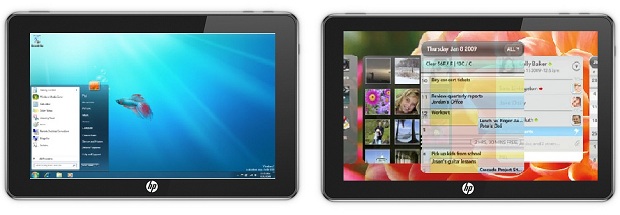
Palmpad, eh? That sounds nice and could signal a sort-of departure from the normal slate business model. HP might be prepping more than one tablet product line. Perhaps the Windows 7 Slate project isn’t dead after all.
We all know the story. HP bought Palm for a billion dollars, partly for the webOS mobile phone platform. Said operating system will soon be found in other HP devices, including printers and tablet computers. However, HP is unlikely to rest its tablet’s future on someone else’s defunct brand name. There will be more than one tablet model from HP right from the beginning.
HP is the king of multi-model product lines. HP has too many notebooks to count between the HP and Compaq brands, and there are even more when their business line-up is considered. The price points between them are often as little as $20, which allows HP to have a notebook for nearly everyone.
There’s no reason to expect anything different from HP’s tablet offering and the Palmpad trademark — if it’s ever used — clearly indicates that. Perhaps the plan all along was to keep the Palm name intact (as with Compaq) and produce webOS devices under that brand. This would allow HP to test the water in the Windows 7’s pool with an HP-branded model instead of relying solely on a Palm-branded tablet.
Palm really hasn’t had a good last five years. Their last hit was the the Palm Treo line, but they held onto Palm OS and WinMo to long. WebOS should be considered a hit, as it’s a phenomenal user experience, but the Pre’s and Pixi’s underwhelming hardware and slow launch ultimately put the last nail in Palm’s coffin.
Consumers know this, too. Palm was the BlackBerry of the late 90’s with a cult-like following and the best mobile experience. But then they slowly died away from the public’s view. However, most consumers know the name and that’s a good thing. As long as HP (and the remaining Palm employees) can show the world they still have the stuff again, the Palmpad might make the run as the real iPad-killer.
Back to the tablets, though.
Spec-wise, they would probably be similar, with the Win7 slate likely getting a slightly more powerful CPU and GPU to meet the demands of the desktop OS. The main difference is really the target market. The Palmpad will no doubt get a lot of social media-ish marketing and flashy TV spots like its direct competitor, the iPad. But the Windows 7 HP Slate — that is if there is one — might be able to get by with just retailer marketing from Best Buy, Office Max and others. After all, the consumer market is only part of its target demographic.
Like it or not, the world runs on Windows and HP makes big money on the small business and enterprise market. A Windows-based tablet could be used in everything from the medical field, to inventory management/logistics, to even the government. Yes, similar apps could be developed for webOS as well, but businesses do not like change and already have the expensive licenses for their existing software. A Windows 7 tablet wouldn’t rock the boat too much, and for some, that’s a good thing.
I’ve said it a dozen times that Windows is horrible on a small-ish touchscreen, but that doesn’t mean HP won’t push forward and sell one anyway simply because the tablet platform is already developed and it could turn out to be a legitimate market.
Then there’s the other possibility that HP will also have a line of self-branded webOS tablets in the beginning competing for the same market as the Palmpad. After all for the first time in HP’s history, they own an operating system and they might want to put their billion dollars to work right away by saturating the tablet market in HP’s traditional fashion. Hopefully we’ll find out by the end of 2010.